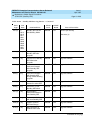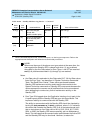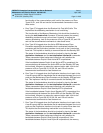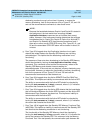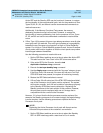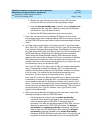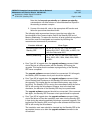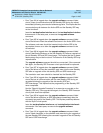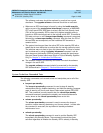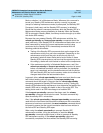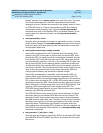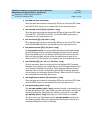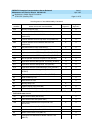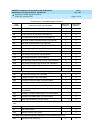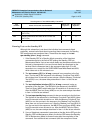
DEFINITY Enterprise Communications Server Release 5
Maintenance and Test for R5vs/si
555-230-123
Issue 1
April 1997
Maintenance Object Repair Procedures
Page 10-1268STBY-SPE (Standby SPE)
10
The software card-mem should be replaced by one that has a good
checksum. The upgrade software command should be re-executed.
y. Whenever an SPE interchange is forced by using the health-override
option as part of the reset system interchange command, a WARNING
OFF circuit pack STBY-SPE alarm is raised, and the Fault Severity Level
(FSL) of the new standby SPE is raised to its highest possible value to
prevent an SPE interchange back to the original active SPE. This artificial
FSL lasts one hour or until a busyout spe-standby command is executed,
followed by a release spe-standby command. After this time, the FSL of
the two SPEs are recomputed, and the healthiest SPE becomes or
remains active.
z. The system interchanged from the active SPE to the standby SPE with a
restart that is more disruptive to service than the normal system hot start.
The switches were not used to force this interchange. The level of restart
can be observed by using the display initcauses command. Look for
other alarms on the standby SPE that possibly caused this interchange.
Also see "Reset System Interchange (High or Critical Reliability Systems
Only)" in Chapter 4, ‘‘
Initialization and Recovery’’.
aa. The software vintage in the Standby SPE does not match the software
vintage in the active SPE.
The upgrade software command should be executed for the standby
SPE as described in Chapter 5, ‘‘
Routine Maintenance Procedures’’.
System Technician-Demanded Tests
The following commands can be used to test and manipulate part or all of the
standby SPE:
■ busyout spe-standby
The busyout spe-standby command is used to stop all standby
maintenance activity, disable shadowing, and hold the standby processor
reset. A warning off circuit pack alarm is also raised against STBY-SPE
MO. This command is more powerful than the refresh spe-standby
command because it preempts the standby and enters maintenance
mode, where as the refresh spe-standby does not do this.
■ release spe-standby
The release spe-standby command is used to remove the busyout
condition, restore memory shadowing, and force a refresh. 1 minute after
the command is executed, the equivalent of standby scheduled
maintenance is run.
■ refresh spe-standby
The refresh spe-standby command is used to put the Standby SPE
immediately into Standby Mode. The command conducts the same
activities regardless of whether the Standby SPE is already in Standby



